Pccn exam 2022 - Study guides, Class notes & Summaries
Looking for the best study guides, study notes and summaries about Pccn exam 2022? On this page you'll find 42 study documents about Pccn exam 2022.
Page 4 out of 42 results
Sort by
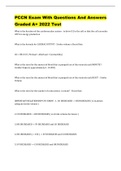
-
PCCN Exam With Questions And Answers Graded A+ 2022 Test
- Exam (elaborations) • 19 pages • 2022
- Available in package deal
-
- $13.99
- + learn more
PCCN Exam With Questions And Answers Graded A+ 2022 Test
PCCN Exam With Questions And Answers Graded A+ 2022 Test
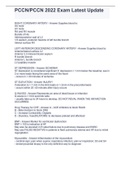
-
PCCN/PCCN 2022 Exam Latest Update
- Exam (elaborations) • 13 pages • 2022
-
- $13.49
- + learn more
RIGHT CORONARY ARTERY Supplies blood to: SA node AV node RA and RV muscle Bundle of His Inferiorposterior wall of LV 1/3 septum, posterior fascicle of left bundle branch Inferior surface RV LEFT ANTERIOR DESCENDING CORONARY ARTERY Supplies blood to: Anterior/lateral surface LV Anterior 2.3 intraventricular septum R bundle branch Anterior L bundle branch LV papillary muscle ST DEPRESSION ISCHEMIA! ST depression is considered significant if: depression > 1 mm below...
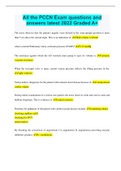
-
All the PCCN Exam questions and answers latest 2022 Graded A+
- Exam (elaborations) • 64 pages • 2022
-
- $9.49
- + learn more
All the PCCN Exam questions and answers latest 2022 Graded A+ The nurse observes that the patient's jugular veins distend in the semi-upright position to more than 5 cm above the sternal angle. This is an indication of: fluid volume overload. what is normal Pulmonary artery occlusion pressure (PAOP)? 5-12 mmHg The resistance against which the left ventricle must pump to eject its volume is: systemic vascular resistance. When the tricuspid valve is open, central venous pressure reflects the ...
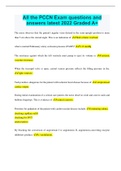
-
All the PCCN Exam questions and answers latest 2022 Graded A+
- Exam (elaborations) • 64 pages • 2022
-
- $15.49
- + learn more
The nurse observes that the patient's jugular veins distend in the semi-upright position to more than 5 cm above the sternal angle. This is an indication of: fluid volume overload. what is normal Pulmonary artery occlusion pressure (PAOP)? 5-12 mmHg The resistance against which the left ventricle must pump to eject its volume is: systemic vascular resistance. When the tricuspid valve is open, central venous pressure reflects the filling pressure in the: right ventricle. Tachycardia is da...
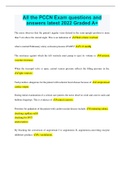
-
All the PCCN Exam questions and answers latest 2022 Graded A+
- Exam (elaborations) • 64 pages • 2022
-
- $14.49
- + learn more
The nurse observes that the patient's jugular veins distend in the semi-upright position to more than 5 cm above the sternal angle. This is an indication of: fluid volume overload. what is normal Pulmonary artery occlusion pressure (PAOP)? 5-12 mmHg The resistance against which the left ventricle must pump to eject its volume is: systemic vascular resistance. When the tricuspid valve is open, central venous pressure reflects the filling pressure in the: right ventricle. Tachycardia is da...
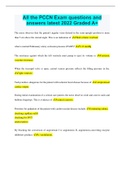
-
All the PCCN Exam questions and answers latest 2022 Graded A+
- Exam (elaborations) • 64 pages • 2022
-
- $7.99
- + learn more
The nurse observes that the patient's jugular veins distend in the semi-upright position to more than 5 cm above the sternal angle. This is an indication of: fluid volume overload. what is normal Pulmonary artery occlusion pressure (PAOP)? 5-12 mmHg The resistance against which the left ventricle must pump to eject its volume is: systemic vascular resistance. When the tricuspid valve is open, central venous pressure reflects the filling pressure in the: right ventricle. Tachycardia is da...
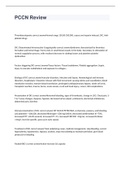
-
PCCN Exam Review 2022/2023 with verified and 100% correct answers
- Exam (elaborations) • 13 pages • 2022
-
- $11.49
- + learn more
hrombocytopenia Normal range 150,00-350,000, causes are heparin induced, DIC, Anti-platelet drugs DIC: Disseminated Intravascular Coagulopathy Syndrome characterized by thrombus formation and hemorrhage. Forms clots in small blood vessels in the body. Secondary to stimulation of normal coagulation process, with resultant decrease in clotting factors and platelets-platelet dysfunction. Factors triggering DIC Tissue factors: Tissue breakdown, Platelet aggregation: Sepsis, Injury t...
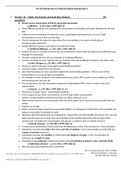
-
RN 200 Introduction to Medical/Surgical Nursing Exam 1
- Exam (elaborations) • 7 pages • 2022
-
- $9.99
- + learn more
RN 200 Introduction to Medical/Surgical Nursing Exam 1 Chapter 16 – Fluids, Electrolytes and Acid-Base Balance (20 questions) Review on the mechanisms of fluid & electrolyte movement: a.Diffusion – p. 271; Wk 1.3 PPT slide 10 Many different processes are involved in the movement of electrolytes and water between the ICF and ECF. Diffusion is the movement of molecules across a permeable membrane from an area of high concentration to one of low concentration The ne...
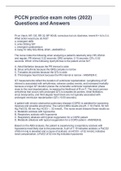
-
PCCN practice exam notes (2022) Questions and Answers
- Exam (elaborations) • 9 pages • 2022
-
- $9.99
- + learn more
Pt on Vtach, HR 135, RR 32, BP 90/48, conscious but c/o dizziness, recent K+ lvl is 3.4. What action would you do first? a. emergent defib b. amio 300mg IVP c. emergent cardioversion d. hang 10 mEq KCL/50mL D5W - ANSWER-C The nurse notes the following when analyzing a patient's telemetry strip: HR, 65/min and regular; PR interval, 0.22 seconds; QRS complex, 0.10 seconds; QTc, 0.52 seconds. Which of the following dysrhythmias is the patient at risk for? A. Atrial fibrillation because t...

Did you know that on average a seller on Stuvia earns $82 per month selling study resources? Hmm, hint, hint. Discover all about earning on Stuvia



